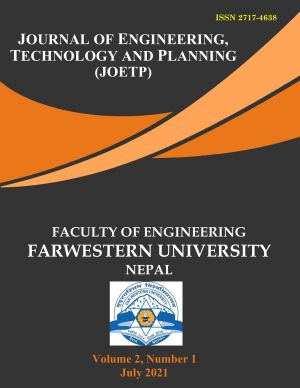Seismic Analysis of Retrofitting of RC Regular Frame with V-Braced Frame
DOI:
https://doi.org/10.3126/joetp.v2i1.39229Keywords:
Capacity curves, ISD, Maximum story displacements, Pushover analysis, Retrofitting, Steel bracingAbstract
Retrofitting of the existing buildings helps to reduce the serious damages under the strong ground motions. In retrofitting techniques, steel bracings are used to resist the lateral load effectively. In this study, the author aimed to investigate the four-story RC frames without and with steel bracings to understand the seismic performances of the buildings. The authors select the V bracings having 7 different thickness of steel bracings ( t= 2.5, 4, 6, 8, 10, 14 and 20mm) and observed the effect in seismic behaviors of the structures in terms of maximum story displacements, inter-story drift (ISD), base shear, fundamental time period (FTP) and capacity curves. In addition, it observed the failure behaviors of the structures. To study the seismic behaviors, the response spectrum analysis and nonlinear static analysis are performed in ETABs software. The result indicates that V bracing improves the seismic performances of the RC frames as well as improves the strength capacity and stiffness of the buildings. Adding bracing in RC frames decreases the top story displacements and inter story drift of the buildings. To get the expected failure mechanism in the braced frames and suitable uniform energy dissipation behaviors, the bracings are designed in such a way that the RC columns should be the main line of defense in the dual systems. Expected failure mechanism is obtained when stronger column, weak beam and weaker bracings design philosophy is used and it is only possible when the columns are designed to resist at least 50% lateral base shear in dual systems. A suitable thickness of bracings which is economical and structurally good should be selected.
Downloads
Downloads
Published
How to Cite
Issue
Section
License
Copyright © Faculty of Engineering, Far Western University

